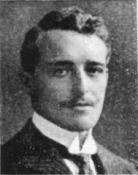
War Memorial
| Lieutenant the Hon William Alfred Morton EDEN | |
|
D Company, 4th Battalion King’s Royal Rifle Corps Date of birth: 15th June 1892 Date of death: 2nd March 1915 Killed in action aged 22 Commemorated on the Menin Gate Panels 51 and 53 |

|
| William Alfred Morton Eden was born at 42 Cadogan Gardens in Chelsea on the 15th of June 1892 the eldest son of William Morton Eden, 5th Baron Auckland, and Lady Sybil Constance Eden (nee Hutton), of The Burrow, Howard Road, Bournemouth in Hampshire. He was educated at Hazelwood School until December 1905 when the school magazine wrote of him: - "He is an excellent rider and keen sportsman all round." He went on to Eton College, where he was in Mr R.S. DeHaviland’s House from January 1906 to December 1908. He was keen on sports and games particularly hunting, shooting, hawking, rowing, football and golf. He went on to the Royal Military College Sandhurst from where he was commissioned as a 2nd Lieutenant in the King’s Royal Rifle Corps on the 22nd of January 1913. He was promoted to Lieutenant in November 1914. on the outbreak of war his battalion was based at Gharia in India and they embarked for England at Bombay on the 12th of October 1914, reaching Plymouth on the 18th of November. After spending the intervening period at Winchester, they embarked once again at Southampton on the 20th of December 1914 and landed at Le Havre the following day. They were entrained, then marched to Blavinghem where they spent some days training for trench warfare. On the 5th of January 1915 they marched out and took over front line trenches from the French at Dickebusch, near St Eloi to the north of Ypres. Conditions in the trenches were appalling with waterlogged trenches being responsible for a large number of cases of trench foot among the officers and men. During this time the Germans had been creeping closer to the British lines by cutting a number of saps out into no man’s land and at one point were as close as ten yards from the British trenches. It was decided to carry out a large scale raid on the new German trenches and this would start by entering a trench known as No. 21. D Company would lead the attack along with a party of twelve bombers under an officer. B and C Companies were to move in behind to consolidate the new position and A Company would be in reserve. Supporting would be two Brigades of artillery who were to fire a shot to signal the beginning of the attack. The night of the 1st/ 2nd of March 1915 was a full moon with a few clouds in the sky to give cover when the Battalion marched up from Dickebusch at 8pm. The opening shot was fired at 12.30am on the 2nd of March, screaming over the heads of the raiders who were huddled in the British front line. The Germans had a machine gun trained on the point where the attacking party were to leave the trench and this began firing as soon as the artillery fire began. Despite some casualties word came back from D Company that they had managed to take about eighty yards of No. 21 trench before they were held up by a barricade. Reports came back that Lieutenants Poe and Eden were attempting to lead their men around it. C Company went forward and discovered the survivors of D Company pinned down by the defenders behind the barricade. Any forward movement brought a hail of fire from the Germans who were well entrenched and the trench was choked with the dead and wounded of both sides. The Germans bombed the attackers out of the captured trench and back into trench No. 21 where they were attacked with more bombs and forced to retire. Survivors reported that William Eden was last seen at the head of his platoon at the barbed wire in front of the barricade and was the first man there. He is reported to have climbed out of the trench on the German side and was last seen running in an attempt to get around it. The survivors of the raid returned to their own trenches as dawn was breaking at 5.45am. Casualties for the raid were three officers missing with two wounded and sixteen others ranks killed with thirty missing and sixty one wounded. He was mentioned in Sir John French's despatches of the 31st of May 1915. The Commonwealth War Graves Commission records his death on the 3rd of March but the regimental history and the battalion was diary both record it as having occurred on the 2nd of March 1915. He was the 50th heir to a peerage to have been killed during the war to that date. Leave to presume death was granted in the Probate Court on the 29th of May 1916 and he was succeeded as heir to the Baronetcy by his brother, Frederick Colvin George. He is commemorated on the war memorial at Eton Collegeand on the memorial at the Royal Military College Sandhurst. |
|
| Went on to Eton College |
Back